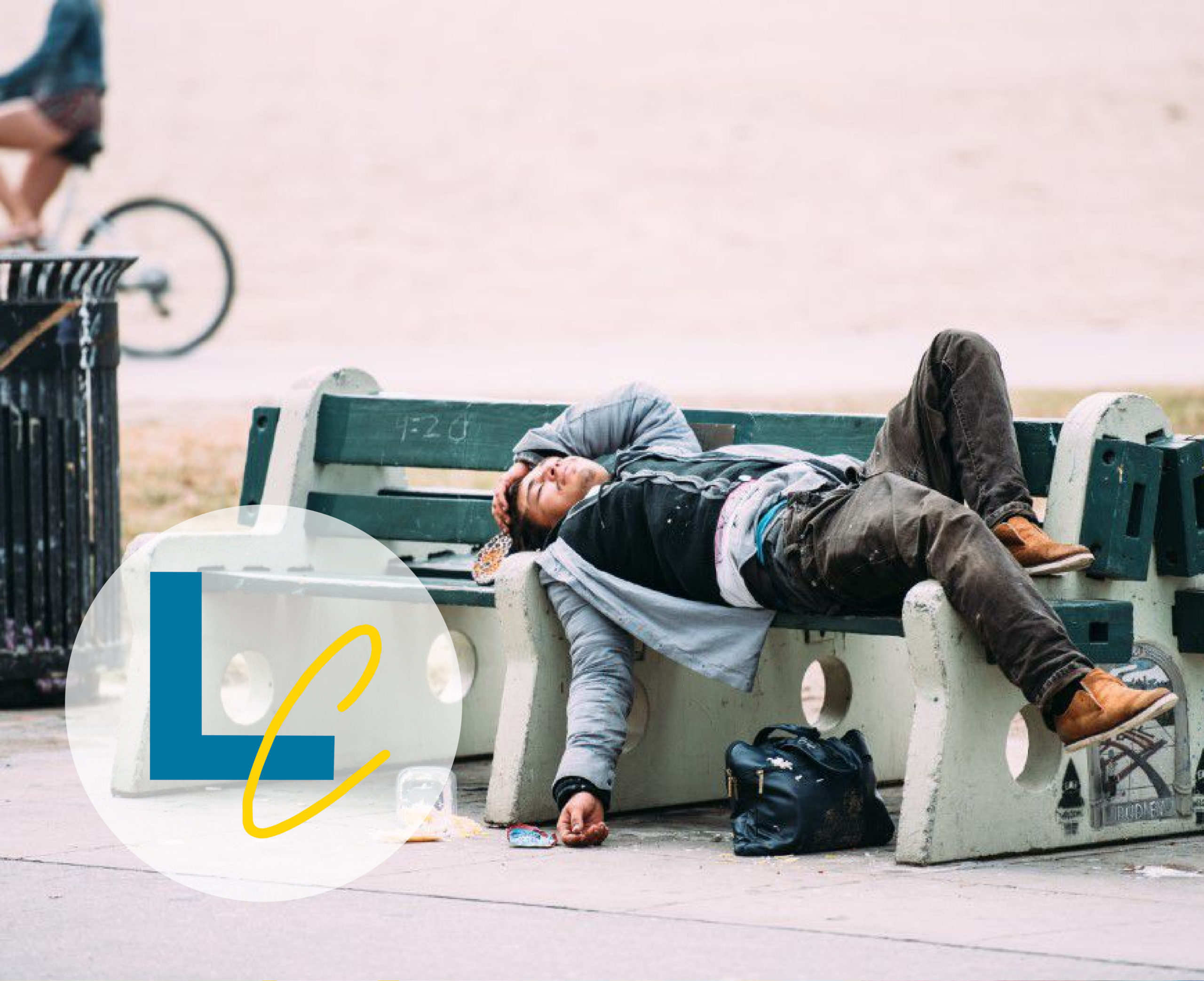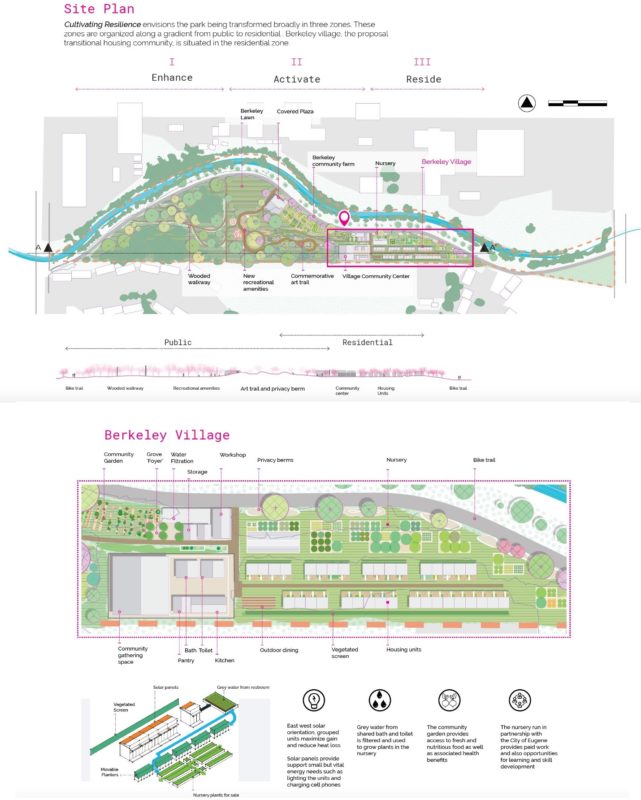
Land Connections–Homelessness in the Built Landscape: How Can We Help?
How do landscape architects address homelessness in the built landscape? What are we doing wrong? What are we doing right? What can we do better? Architects, Civil Engineers, Landscape Architects, and Urban Planners in the public and private sectors have a responsibility to design cities that serve the entire community, including the homeless. Government policies, laws, donations, volunteers, social services, and non-profit organizations help people without shelter, but innovative design can also contribute to their success in leading people out of homelessness.
What Are We Doing Wrong?

As design professionals, we are ignoring our responsibility to govern our designs to help those experiencing homelessness. We have implemented many environmental regulations that govern design such as MWELO, CAL GREEN, and LEED; We have implemented many physical diversity and safety regulations that govern design such as ADA and OSHA; But what about socio-economic regulations that govern design? Should we be allowed to create spaces that continue to marginalize the needs of thousands of people? Should we be allowed to use hostile design techniques without any mitigation design to make up for the displacement of the people we deter? Should we be allowed to design in a way that promotes gentrification with no regard to the effects it has on communities as a whole? Sure, we can regulate how much water we put on our lawns but regulating design based on the needs of people without shelter? Unheard of. Why is this the case? Perhaps this happens because people aren’t afraid of those who are unable to threaten litigation over unjust designs and unjust laws preventing them from sleeping in public spaces. But these people have and can use the law! The justices’ decision in the Martin v. City of Boise case effectively upheld a Ninth Circuit Court ruling that “as long as there is no option of sleeping indoors, the government cannot criminalize indigent, homeless people for sleeping outdoors, on public property, on the false premise they had a choice in the matter.” (3)
“Once public spaces shed a welcoming humane environment, it is not only the targeted “undesirables” who lose their dignity, but also the entirety of the city’s population itself.” (4.b)
It was while riding on the Metro Red Line I had an unforgettable conversation with a total stranger. He called himself an “architect”. “I had a huge motorcycle accident and got this,” revealing a fake right leg. “I lost everything from that: my girlfriend, my house…everything.” He is now homeless, living on the streets and parks within Koreatown, Los Angeles. “You know, Ktown is great! People dump their beds and nice furniture…so I built my bedroom and design stuff, just like an architect.” This made me laugh, with respect. After I told him I am a landscape architect, he appeared pleased with this newly shared information and asked, “Do you know AutoCAD?”
Personal Experience of Yiran Wang (4c)
What Are We Doing Right?

The following three examples show how people are trying to provide positive changes for communities experiencing homelessness and are opportunities for design professionals to be more involved.
- The Sleep Center in Walla Walla, Washington is organized on a parcel of publicly owned land. It provides a place to sleep at night for anyone who needs it. The Sleep Center consists of 31 unheated Conestoga huts that are six feet by ten feet. Showers, food, and lockable storage totes are also available. There are plans for a vegetable garden. There are rules at the Sleep Center that help provide more safety and security than the open streets. The Alliance for the Homeless is now developing case-management protocols to help its clients secure identification, connect with services, and reestablish relationships with estranged family members. Yet more needs to be done to find viable exits from homelessness. Housing First acknowledges that having a safe, stable, supportive place to sleep is the first, essential step in leaving homelessness, which is why efforts like the Sleeping Center are viewed as an important triage. (3)
- SITELAB Urban Studio works with Lava Mae to repurpose old buses into showers and toilets to serve homeless populations in San Francisco. The Lava Mae popup care village explores how the design of public space can better serve vulnerable populations. Brie Hensold, ASLA, a Principal at Sasaki, notes a common thread between cities that are making progress is that they try to listen to the individuals and build relationships with the homeless communities. This allows key individuals in the homeless population to become ambassadors and problem solvers. One such instance is found at Gladys Park in Los Angeles. (2)
- The Skid Row Housing Trust of Los Angeles works with local architecture firms such as Michael Maltzan, Killefer Flammang Architects, Koning Eizenberg Architecture, and Brooks + Scarpa to design apartments for individuals who were formerly living on the streets. The design of these buildings and programming offers medical clinics, onsite counselors, community rooms, community farming and roof gardens, and courtyards that help support outdoor spaces for community activities. They have created a shift in the design of shelters and housing for the homeless to be just as appealing as housing complexes being constructed in Downtown Los Angeles. (4d)
I realized Landscape Architects and the homeless will be inextricably tied together for the foreseeable future, falling onto us to responsibly and compassionately deal with the social, health, and design issues connected with homelessness in our public parks. As park agencies and Landscape Architects renovate our City’s aging park infrastructure, we are tasked to consider the homeless as a major user and stakeholder in our park designs guided by the ideals of “compassionate coexistence“.
Gary J. Lai (4a)
What Could We Do Better?
Hostile design techniques, sloped benches, night lighting, thorny plants, night watering, police patrol, no loitering laws, curfews, and park hours only clearly declares a “Not here!” mentality. So where? We must help provide places in the built landscape for the homeless. Landscape Architects can create more suitable places for the homeless to live through master planning, connection with the community, site specific design, municipality education, and donation of services.
Master Planning
We all have the potential to slide up and down the available housing spectrum from multi-million-dollar homes to homeless shelters. All housing options should be available and planned for during City planning and development. Housing market concerns and the balance of property value and property type are among the challenges of Urban Planners and zoning. Part of city development should seek to group assistance resources and work opportunities with areas designed for the homeless. City planners can optimize urban planning to offer well-rounded, transit-oriented development emphasizing both physical and social infrastructure. Services may be housing-oriented, and materials used need to have proven longevity and low maintenance requirements. Acknowledging that homelessness is part of the urbanscape and designing more emphatically towards that end, is the need of the hour. (5)
Connection with the Community
Helping is so much more effective when relationships are built. We can connect with the community by:
- Seeking out homeless individuals and going where they are.
- Creating forums for homeless individuals to advocate for themselves at every scale from park and shelter design to local and federal housing policy.
- Providing settings for conflicting parties to negotiate face-to-face. Like most Americans at the margins of society, few are likely to attend formal workshops or public hearings so be creatively humanistic and engage on their turf.
- Discovering their resources of personality, skill, and materials so they can advocate for themselves. This builds self-respect, realistic hope, and empowerment.
- Bringing neighbors, policy makers and experts to the homeless community’s table.
- Understanding that among the homeless there are good problem solvers. In each unique place, ask them directly to tell us their needs so we can begin to develop categories of spatial and policy need.
- Meeting the individuals, looking them in the eye, and listening between the lines. (6)
Site Specific Design
Specific design elements and techniques can be implemented into new projects such as:
- Start small. Provide simple “Sleep Safely Here” maps that give information for shelters and other resources. Then consider specifying a donation station. There never seems to be enough money or enough money going in the right places. Some people feel good about dropping a few dollars into a cup or handing money out of their car window, but giving cash to people on the street may not be the best way to help them in the long term. The money may be used irresponsibly for drugs and alcohol, and it might promote rather than discourage street living. Non-cash donation stations within areas with high rates of homelessness may be a great way to ensure the money is going to be used in a healthy way and supports programs with the goal to help people exit homelessness. With a simple swipe, tap, or QR scan we could help the people we pass by on the street.
- Design with established organizations, such as Safe Ground Sacramento. Their mission is to: “Advocate for the decriminalization of homelessness and establishment of Safe Ground communities where those who are experiencing homelessness may reside until they may obtain housing.”
- Create innovative design. A group of students proposed the “Cultivating Resilience” plan that envisioned a city park that embraces the homeless population who are already using the space for transitional shelter, while enhancing park quality for neighbors and increasing resilience. (See samples from the plan below.) The transitional housing community has a modular, off-grid infrastructure that can be rapidly deployable and removable while providing basic needs like food, energy, and water on-site. (1)

Municipality and Owner Education
A common response to this discussion is, “But it is the investors, owners, builders, and Cities that pay for these designs, and we have to give them what they want because it is their money.” As design professionals, we provide vision, programing, marketability, innovation, artistry, and education. We educate the investors, owners, builders, and Cities as to why society should design for the environment, for the physically diverse, and for safety, meanwhile we can educate them about the benefits of designing with and for the unsheltered. What are the benefits?
- Cities that serve the entire community become stronger, more desirable, more profitable, safer, and most importantly become more ethical.
- Cities that serve all people of a variety of economic stature, regain the value of public spaces as places to celebrate, play, relax, shop, educate, and enjoy life.
What investor or City wouldn’t want to realize these benefits? Cities spend millions of dollars managing storm water, traffic, and public schools because they have recognized that weather, traffic, and children’s education are systems that will never disappear and are systems that need management. Homelessness is also one of those systems that need management, donations, government assistance, and planning.
Donation of Services
Donations of services and items can be more impactful than money alone. The brunt of the work, however, falls on churches and volunteers who provide food, showers, and laundry. Service donations from a variety of companies would alleviate many needs and challenges. Designing for these service and item donations may make it more organized, easier, and more appealing for the companies to donate services such as:
- Garbage service
- Laundry service
- Storage units
- Portable Restroom Service
- Health screening
- Drug rehab services
- Mental health services
- Camping gear donations
- Clothing donations
- Construction donations
- DESIGN SERVICES
- and more…….
All of this is easier said than done, but as a society and a community we must try to alleviate the hardships of people who could use help and guidance. Implementing innovative design ideas may be the foundation of a sympathetic system that heals and helps people out of homelessness.

References
1. https://thefield.asla.org/2020/12/08/landscape-architecture-tackles-homelessness-and-shelter-in-the-pandemic/ Landscape Architecture tackles Homelessness and Shelter in the Pandemic by Yekang Ko, PhD, and Cory Parker, PhD, PLA
2. https://dirt.asla.org/2017/10/23/how-3-cities-are-addressing-homelessness/ The Dirt -How 3 Cities Are Addressing Homelessness by Dana Davidsen
3. https://landscapearchitecturemagazine.org/2020/02/04/public-space-no-exceptions/ Public Space, No Exceptions By Brice Maryman, FASLA
4. https://ahbelab.com/tag/homeless/
4.a Los Angeles, Our Homeless, and Designing for Compassionate Coexistence by Gary J. Lai
4.b Designer in Distrust: Peering Over the Invisible Wall of Homelessness By Yiran Wang
4.c The Invisible City of Los Angeles By Yiran Wang
4.d Designing for Shelter, Community, and Safety By Wendy Chan
5. https://www.re-thinkingthefuture.com/designing-for-typologies/a2857-homelessness-in-architecture-and-how-architects-can-help/ Homelessness in Architecture and How Architects Can Help By Shreya Vadrevu
6. https://pdf4pro.com/view/designing-with-the-homeless-introduction-48e3a2.html DESIGNING WITH THE HOMELESS- ASLA 2015 Annual Meeting and Expo RANDOLPH HESTER – Professor of Landscape Architecture & Environmental Planning | UC Berkeley CAROL MAYER-REED – Landscape Architect, Partner | Mayer/Reed, Inc. KATHERINE EASTMAN – Landscape Designer & Planner
About the Author

Vicky Ringleb, PLA, QSD/QSP, is a Landscape Architect at O’Dell Engineering. She has over 15 years of experience in the industry and holds a BS in Landscape Architecture from UC Davis. Vicky is passionate about the design of inclusive spaces and loves to see all community members finding happiness and joy in the public spaces she designs.
Learn More
For previous Land Connections articles, click here.
For information on joining the O’Dell Engineering team, click here.
To see our landscape architecture project experience, click here.
Go Back